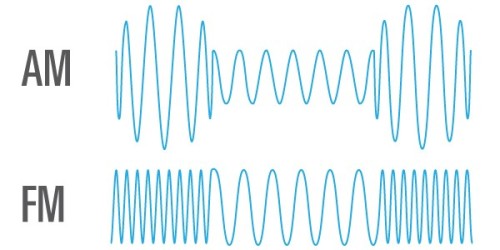AM & FM: How Radio Works

AM & FM: How Radio Works
Lately I’ve been thinking about how the things I use every day actually work, and since I listen to a lot of podcasts, you can guess where this post is going: radio.
In a studio, a microphone converts sound waves from a person’s voice into an electronic audio signal. If this was sent out by itself, it would only travel a few metres in air before it faded out. To get radio waves to travel long kilometres to a receiver, we have to combine it with a “carrier wave”—an electromagnetic wave.
Electromagnetic waves are made up of oscillating electric and magnetic fields, just like visible light, but radio waves are right down on the lower end of the spectrum, so their wavelengths are very long—around 300 metres.

(Image Credit: NASA)
Sound information is combined with the wave by altering or modulating the wave’s properties, like changing its amplitude, frequency, or phase. There are two ways to combine the audio signal with the carrier wave: amplitude modulation (AM) or frequency modulation (FM).
AM radio changes the overall amplitude or strength of the wave, varying its height in order to incorporate the sound information. FM radio works a little differently, because it changes the frequency of the wave rather than the amplitude. The frequency is the number of wavelengths that pass by a given point per second—physically, a high frequency wave would look squashed up, and a low frequency wave would look stretched out.

(Image Credit: Wikimedia Commons)
Both kinds of waves are susceptible to variations in amplitude as they zoom off through the air, but since FM radio relies on changes in frequency rather than amplitude, these variations don’t matter—they can just be ignored, and so the sound quality is usually super clear. But AM radio relies on the amplitude to convey information, so when the amplitude is varied a bit, this results in interference or static, which will be a familiar idea if you’ve ever listened to AM radio on a rural country road. The upside of AM radio is that it travels much further than FM radio, which is probably why you’re listening to it on that rural country road in the first place.
So once these radio waves—whether AM or FM—hit a radio receiver, their oscillating fields induce a current in the conductor. The sound information encoded into the waves can be extracted, and converted back to sound waves to grace your ears with your favourite music or talk show.
(Bonus: if you want to use science to learn more cool science, my fave podcasts are Radiolab, the Infinite Monkey Cage, and Big Picture Science.)
More Posts from Thekrishankumar and Others

The Burj Khalifa (Downtown Dubai, UAE)
By Freddie Ardley Photography
Check out Freddie’s: Instagram Facebook Website


Between 470 million to 760 million people worldwide could lose their land to rising seas if global warming is allowed to continue unbridled, says a study conducted by scientists at Climate Central, a nonprofit research and news organization. In this photograph by Shahria Sharmin of @ap.images, Saleha, 38, who lost her land to river erosion, stands in a field that she farms with her husband in exchange for a place to stay in the island district of Bhola, where the Meghna River spills into the Bay of Bengal, Bangladesh. For more on the UNited Nations Climate Change summit in Paris, France, visit TIME.com. http://ift.tt/1RnIReR

Macchu Picchu is not a Pokemon.
"Macchu Picchu I choose you!" (via wtfparentingquotes)

Tumblr Tuesday: Earth Day
Fursty Photo (furstyphoto) Earth Day is about critical issues facing our planet, but sometimes it’s also about how goddamned beautiful a mountain is. Look.
Miss Marine Bio (missmarinebio) The ocean is as terrifying as it is amazing, full of sharks and maybe even the ghosts of dead sharks. Lucky for us, Miss Bio is going where few of us are brave enough to go, and she’s taking pictures along the way.
Earth Street (earthstreet) Imagine if someone stopped you on the street, took your picture, and asked you what you thought about the Earth. Caren didn’t have to imagine it. Good job, Caren.
Exoteric Environmentalism (exotericenvironmentalism) If you’re into cool facts, you’re into this blog. If you’re into dumb lies, we don’t know what to recommend you, but we still respect you.
Marine Conservation (marine-conservation) Now that we all agree ghost sharks exist, please read this blog to educate yourself on man-sized swimming centipedes.
Landscape via erosion, tectonics, volcanoes, etc. Human via sperm and egg. Photo of landscape via furstyphoto








Enlightening Walks in British Woodlands
By Freddie Ardley Photography
Website | Facebook | Instagram | Twitter
-
 scottodomain liked this · 4 years ago
scottodomain liked this · 4 years ago -
 wengelbert liked this · 5 years ago
wengelbert liked this · 5 years ago -
 go-wind-stuff reblogged this · 5 years ago
go-wind-stuff reblogged this · 5 years ago -
 go-wind-stuff reblogged this · 6 years ago
go-wind-stuff reblogged this · 6 years ago -
 milothemagicfishbag liked this · 6 years ago
milothemagicfishbag liked this · 6 years ago -
 temencmoth reblogged this · 6 years ago
temencmoth reblogged this · 6 years ago -
 mxpartyhardy liked this · 6 years ago
mxpartyhardy liked this · 6 years ago -
 an-obsession-blog reblogged this · 6 years ago
an-obsession-blog reblogged this · 6 years ago -
 rejectedproject liked this · 6 years ago
rejectedproject liked this · 6 years ago -
 corrupted-willy reblogged this · 6 years ago
corrupted-willy reblogged this · 6 years ago -
 fanatic564 liked this · 6 years ago
fanatic564 liked this · 6 years ago -
 cieltheanon liked this · 6 years ago
cieltheanon liked this · 6 years ago -
 impossiblepentagon liked this · 6 years ago
impossiblepentagon liked this · 6 years ago -
 shadowwolf146 liked this · 6 years ago
shadowwolf146 liked this · 6 years ago -
 a-murder-of-anxious-crows reblogged this · 6 years ago
a-murder-of-anxious-crows reblogged this · 6 years ago -
 a-murder-of-anxious-crows liked this · 6 years ago
a-murder-of-anxious-crows liked this · 6 years ago -
 recycling-friend liked this · 6 years ago
recycling-friend liked this · 6 years ago -
 armameery reblogged this · 6 years ago
armameery reblogged this · 6 years ago -
 armameery liked this · 6 years ago
armameery liked this · 6 years ago -
 smokeyrutilequartz liked this · 6 years ago
smokeyrutilequartz liked this · 6 years ago -
 datonerougecookeh liked this · 6 years ago
datonerougecookeh liked this · 6 years ago -
 datonerougecookeh reblogged this · 6 years ago
datonerougecookeh reblogged this · 6 years ago -
 sailor-pom reblogged this · 6 years ago
sailor-pom reblogged this · 6 years ago -
 kingshadows1001 liked this · 6 years ago
kingshadows1001 liked this · 6 years ago -
 fireicelapis liked this · 6 years ago
fireicelapis liked this · 6 years ago -
 pailettehazel liked this · 6 years ago
pailettehazel liked this · 6 years ago -
 logan-exe reblogged this · 6 years ago
logan-exe reblogged this · 6 years ago -
 honeydukeshearts reblogged this · 7 years ago
honeydukeshearts reblogged this · 7 years ago -
 schweizerqualitaet liked this · 7 years ago
schweizerqualitaet liked this · 7 years ago -
 sweethonnie-blog1 liked this · 7 years ago
sweethonnie-blog1 liked this · 7 years ago -
 blavckquofee-blog liked this · 7 years ago
blavckquofee-blog liked this · 7 years ago -
 lightupdarkness liked this · 7 years ago
lightupdarkness liked this · 7 years ago -
 davkolnikov-blog reblogged this · 8 years ago
davkolnikov-blog reblogged this · 8 years ago -
 davkolnikov-blog liked this · 8 years ago
davkolnikov-blog liked this · 8 years ago -
 thothopic liked this · 8 years ago
thothopic liked this · 8 years ago -
 i-am-carbon14 reblogged this · 8 years ago
i-am-carbon14 reblogged this · 8 years ago -
 ghostlypostavenue reblogged this · 8 years ago
ghostlypostavenue reblogged this · 8 years ago -
 sxphieart-blog liked this · 8 years ago
sxphieart-blog liked this · 8 years ago -
 pensine-privee-blog liked this · 8 years ago
pensine-privee-blog liked this · 8 years ago -
 tomicemoby liked this · 8 years ago
tomicemoby liked this · 8 years ago
16, I love Technology & Science Stuff . krishan@krishankumar.me
82 posts

